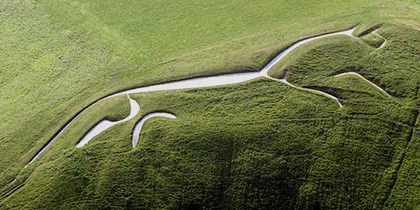
February 14, 2013, by Guest blog
Horses for courses?
Horses for Courses?
With horse meat being big news I had to think back on my own PhD which was all about food and drink in Anglo-Saxon England. If there is one thing certain in medieval times, it is that people most definitely knew where their food was coming from. Other than luxury goods, such as exotic spices, as, for example, cinnamon, most meals would have been grown and harvested within a few miles of the homestead. The diet of the Anglo-Saxons contained all kinds of animals, if we can believe the various written records and archaeological remains horse meat was also part of the diet. So when did the English become squeamish about the eating of horse meat?
A look back to the early medieval period shows that horses were cherished animals. Horse burials appear in several Anglo-Saxon cemeteries, although they are quite rare and thus perhaps an indicator of wealth and status. Horses play an important part in Anglo-Saxon art and culture. After all, the first chieftains of the ‘English’ people, according to the Venerable Bede, are said to have been the brothers Hengist and Horsa, both names literally meaning ‘horse’.
While early Christian church writers considered the status of various food stuffs, there is no mention of horse. It may have been that horses were expensive and that not many people would have been able to get such a luxury item. An indication that horse was rarely on the menu comes from the Canons of Theodore, attributed to Theodore of Tarsus, Archbishop of Canterbury, from the late seventh century state that ‘Hors we na forbeodað, ac hit is ungewunelic to etanne’ – We do not forbid the eating of horse [meat], but it is unusual to be eaten.[i] This ecclesiastical law code was a guidance for both, the laity and clergy. In AD 723 Pope Gregory III instructs the Anglo-Saxon missionary Boniface to ban the eating of horsemeat among the Germans. Many scholars have assumed that this is because horses may have been associated with pagan sacrifices and worship. However, Ann Hagen, who has written extensively about Anglo-Saxon food, observes that this is the year of the Battle of Tour in which Christians encountered mounted Muslim army which may have made horses a necessity for warfare.[ii]
It is not before AD 786 when horse meat is explicitly forbidden in an English context. An edict is sent from Pope Hadrian who forbids the English to mutilate and eat horses, because it is a relic of a pagan ritual. This edict may be the result of a visit by papal legates at the Synod of Chelsea in 785 who observed the eating of horsemeat among the English. Whether this edict was widely observed is questionable. Frequent famine and war may have made the eating of all kinds of things a necessity, as for example, the Danish army which is said to have eaten their horses as a result of famine in 893.
The eating of horse meat continued in the north. When the Icelanders agreed to convert to Christianity in the year 1000 they did so with the caveat of being allowed to continue to eat horse meat, which, as Icelandic sources tell us, were abolished a few years later.
The taboos around eating horses go back a long way and appear to be religiously motivated. However, the Anglo-Saxons and Vikings were pragmatic people. Religion often emphasized sensible ideas: for example, handbooks of penance forbid the eating of contaminated foods – such as foods that have come into contact with carrion birds or vermin. These animals spread disease, so in a way the religious edict protects ordinary people and punishes those who add them to the food chain. Don’t we wish we had a little of the same protection today?
[i] R. Fulk and S. Jurasinski eds, The Old English Canon of Theodore (Oxford 2012), 4.
[ii] A Second Handbook of Anglo-Saxon Food and Drink: Production and Distribution (Hockwold-cum-Wilton, 1995), 188.

More horsemeat here (by a former Nottingham student): http://www.academia.edu/2570631/Horses_for_Courses_Religious_Change_and_Dietary_Shifts_in_Anglo-Saxon_England